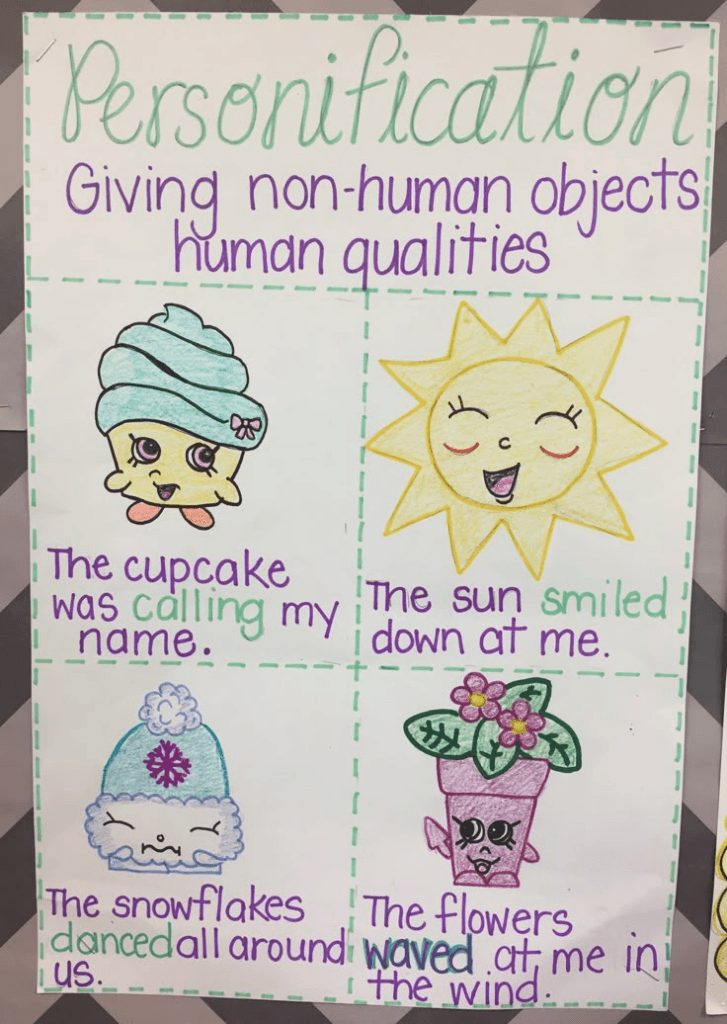Personification examples in literature: A teacher’s guide
In this guide
- What is personification and why is it used in writing?
- Memorable personification examples from classic and modern literature
- Teaching tips for helping students identify and analyse personification
- Writing exercises to help students use personification in their own work
- Classroom activities for reinforcing figurative language
What is personification and why is it used in writing?
Personification is a form of figurative language where an author gives human characteristics to something that is not human.
The sun smiles down on the meadow, for example, is an example of personification. The sun does not have a face and cannot smile, but the use of personification in this instance creates a happy and pleasant scene.
Personification examples are used in literature and poetry to make writing more relatable to the reader. A writer may use personification to characterise abstract concepts like love, justice, or peace. This helps readers to better understand the concept, but also to relate it to the characters in a story or to their own lives.
Peace settled over the town like a warm blanket,
quieting the houses and closing tired eyes.
This sentence is an example of imagery helping to relate an abstract concept like peace and the feelings associated with that concept. The reader recognises the tiredness and can relate to peace being a town falling asleep. Peace cannot physically close eyes or quiet anything because those are human characteristics.
Personification is also used to enhance imagery within literature and poetry. Imagery can be used to help a writer create a richer environment. By using personification to enhance imagery, the writer helps the reader to see, hear, taste, smell, and feel the writing at a deeper level.
An example of imagery being enhanced by personification can be found in the sentence:
The autumn wind played tag with the fallen leaves,
chasing them down the deserted sidewalk.
In this sentence, the wind and leaves are “playing tag” which is a human characteristic. Human children play tag, but the use of personification in this situation creates a sense of fun and playfulness in a “deserted” space.
Memorable personification examples from classic and modern literature

Examples of personification can be found in classic and modern literature. They can be found across genres and in literature for all age groups. Below are examples from both classic and modern literature that span across age groups.
The final category in this section includes personification examples that can be found in picture books. Picture and story books are an excellent way to introduce examples of personification, even for older students.
1) Personification in classic literature
Charlotte’s Web – E.B. White
- In this classic tale, the spider, Charlotte, “makes a plan” to save Wilbur the pig. Spiders do not make plans, at least not in the human sense.
- This book also gives multiple examples of anthropomorphism, which is a type of personification where living characters like pets or wild animals, take on human characteristics.
The Tale of Peter Rabbit – Beatrix Potter
- The animals in this tale have human qualities. There are “friendly sparrows” and a “naughty” rabbit.
- The animals are given these characteristics to make the story more engaging. They also serve to teach children a lesson about curiosity and disobedience.
The Tell-Tale Heart – Edgar Allan Poe
- Personification examples are commonplace in the works of Edgar Allan Poe, particularly examples involving death.
- The Tell-Tale Heart is no exception. In this story, death is a character in itself. Death “stalks” and moves like a human. Death makes a person its victim as if it were a human with instincts and motives.
Romeo and Juliet – William Shakespeare
- Shakespeare uses many examples of figurative language throughout his works.
- In Romeo and Juliet there are several personification examples during the balcony scene between Romeo and Juliet. Romeo says “Arise, fair sun, and kill the envious moon, who is already sick and pale with grief, that thou, her maid, art far more fair than she.” The sun cannot kill and the moon cannot be envious or grief-stricken, yet the words are used to create the scene for Shakespeare’s audience.
“Because I could not stop for Death” – Emily Dickinson
- Emily Dickinson personifies death in this poem. Dickinson writes that Death “kindly stopped for me” and that he “slowly drove – He knew no haste.”
- In this example, death becomes human-like and can drive a carriage and visit Dickinson at home.
The Odyssey – Homer
- Homer’s classic tale of the journey of Odysseus and his adventures while trying to return home is well known and memorable.
- One of many examples of personification in this tale is “The ship danced over the waves, eager to return to Ithaca.” Ships do not have feelings but this example shows the eagerness with which Odysseus wants to return home.
2) Personification in modern literature
The Giving Tree – Shel Silverstein
- “Once there was a tree, and she loved a little boy.”
- “And the tree was happy.”
- In this tale, a tree and a little boy grow together. The tree gives the boy all she has and it makes her happy.
- Love, giving, and happiness are human characteristics given to the tree.
Animal Farm – George Orwell
- Animal Farm has many examples of both personification and anthropomorphism.
- Anthropomorphism is a specific type of personification where animals are given human characteristics.
- The animals in Orwell’s novel behave and display human characteristics such as anger, reasoning, and fear.
There are also examples of traditional personification like in the sentence
- “The windmill loomed over the farm, its blades turning with a relentless determination.”
- Windmills just work, they are not determined.

Fahrenheit 451 – Ray Bradbury
- Fire is frequently personified in this dystopian novel about burning books, government control, and firemen who set fires.
- “The fire’s fingers reached out, devouring the pages of the forbidden books.”
- Fire does not have fingers, nor does it eat.
“Mirror” – Sylvia Plath
- Plath’s poem about a mirror is an excellent example of personification as the poem is told from the point of view of the mirror.
- The mirror says, “I am not cruel, only truthful — the eye of a little god, four-cornered. Most of the time I meditate on the opposite wall.”
- Cruelty, truthfulness, and meditation are human characteristics and actions.
Night – Elie Wiesel
- Wiesel’s memoir is his account of his time as a teenager in the Nazi death camp, Auschwitz. It is a sad, harrowing, and deeply moving account of a terrible time in history.
- Examples of personification and other figurative language can be found throughout, such as “A calm, reassuring wind blew through our homes.”
- Wind does not have the human ability to be calm or reassuring.
Their Eyes Were Watching God – Zora Neale Hurston
- This novel is an example of literature that came from the Harlem Renaissance.
- Throughout the story, the main character, Janie Crawford, personifies death.
- “Death, that strange being with the huge square toes who lived way in the West.”
- In this text, death is given physical human characteristics like toes and a place to live.
The Hunger Games – Suzanne Collins
- This book contains several examples of nature personified.
- “The sun persists in rising, so I make myself stand.”
- The sun does not make the decision whether to rise or set, but this example of personification shows the main character’s annoyance that the sun continues to rise and so must she.
3) Personification in picture books
The House Without Lights – Nadia Alam
- A house is the main character in this story about the celebration of Eid.
“Outside in” – Cindy Derby
- This story gives human characteristics to “Outside” and examines our relationship with nature.
“The Dark” – Lemony Snicket
- “The Dark” is personified as a living being that hides in closets and waits around corners.
“Old Wood Boat” – Nikki McClure
- In this story about a family restoring an old boat, the boat is personified and can “remember the wind”.
“School’s First Day of School” – Adam Rex
- This is a great story for back to school and the nerves that can accompany that event. School is nervous about the first day and meeting the students and teachers.
“Creepy Carrots!” – Aaron Reynolds
- My own children loved this story about Jasper Rabbit and the carrots that “haunt” him because he loves to eat them.
Teaching tips for helping students identify and analyse personification
1) Identifying personification

Use picture books
Picture books are a great resource for introducing personification (or other types of figurative language) to students, even older students.
Often these types of books have explicit examples of figurative language that are easy to identify.
Anchor charts
Anchor charts are a visual aid that helps students to remember and apply concepts and information.
Displaying and referencing anchor charts during learning gives students a resource for remembering and recalling. Anchor charts can be modified to be appropriate for any year group.
Here are a few examples of personification anchor charts:


2) Analysing personification
Close reading strategies
Close reading is a strategy where students carefully examine a specific part of a text. In this instance, students would be looking closely at an example of personification within a text.
Students should consider these guiding questions as they read –
- What is being personified in this text?
- What is the human action or attribute given to the non-human object?
- Why might the author choose to personify this?
These questions can be part of a class discussion or students’ annotations depending on the developmental level of the students.
Analysis chart
Creating a chart or graphic organiser to help students organise their analysis of personification in a text can be useful. This chart can be used throughout the reading of a text or for one specific example.
Here is one example of a chart that could be used or modified to fit the needs of any classroom:
| Personification in ____________. | |
| Quote with personification and page number: | |
| Object being personified: | |
| Human characteristics: | |
| How does this example impact the story? | |
| How does this example impact the imagery in the text? | |
Writing exercises to help students use personification in their own work
Gallery walk
- Display several examples of objects around the room on large chart paper.
- Students walk around the room and add examples of human characteristics that the object could be given.
- After the gallery walk, students write a paragraph or short story using one of the objects.
Feeling weather
- In this activity, students practise using personification examples in their own writing.
- Choose a weather phenomenon such as lightning, hurricanes, or winter and write a paragraph or story as told from the perspective of that type of weather.
- This type of writing gives students an opportunity to explore point-of-view when writing.
Emotions speak
Similar to writing about the weather, in this activity, students personify emotion.
Emotions and feelings can be big and confusing. Not only can this help students to write using personification, but it can also help with processing and understanding emotions.
Abstract character
- Using examples like Edgar Allan Poe and Emily Dickinson, students choose an abstract concept and write it as a character.
- Writing excerpts can include a poem, a short story, comic strip, or a podcast script.
- This activity would be more suited to older students that have a better understanding of the abstract.
- Abstract concepts such as love, fear, grief, success, and individuality all make excellent topics.
Classroom activities for reinforcing figurative language
Picture cards
Picture cards can be used by students to write their own examples of figurative language.
- Give students pictures of various landscapes, weather scenes, animals, objects like clocks, phones, or clothing, fantasy scenes, etc.
- Students use the cards to write examples of figurative language.
- They can be assigned a specific type of figurative language such as a metaphor, simile, alliteration, imagery, etc.
- They can write as many examples of figurative language as they can.
- Give students time to think and be creative.
Figurative language in music
Music is a form of poetry. Give students examples of figurative language found in song lyrics.
- Students choose a school-appropriate song and identify examples of figurative language within the song.
- For younger students, give students the option of using nursery rhymes to find figurative language.
- A fun activity to do is for students to illustrate the examples of figurative language. My English students have done this activity and it allows them to think creatively and visualise the figurative language.
Literature “I Spy” poster
- Create a poster to be displayed in the classroom.
- While reading various types of literature, identify examples of figurative language.
- Include the examples on the poster.
- Add to the poster over the course of reading.
The example below comes from the book Wonder, but this activity can be done for any piece of literature.

Teaching personification and other types of figurative language can be fun for students and teachers. Exploring various types of literature and the forms of figurative language within them allows students to more deeply understand the writing and how authors make choices in their writing.

Mattie Farrer
briefcase iconAVID Site Coordinator / Content Curator
Mattie Farrer has been an educator in various grade levels and capacities during her career. She has a passion for supporting English learners and their language development. She also loves helping teachers reach all students.
Other posts
Want more content like this?
Subscribe for blog updates, monthly video releases, trending topics, and exclusive content delivered straight to your inbox.


















